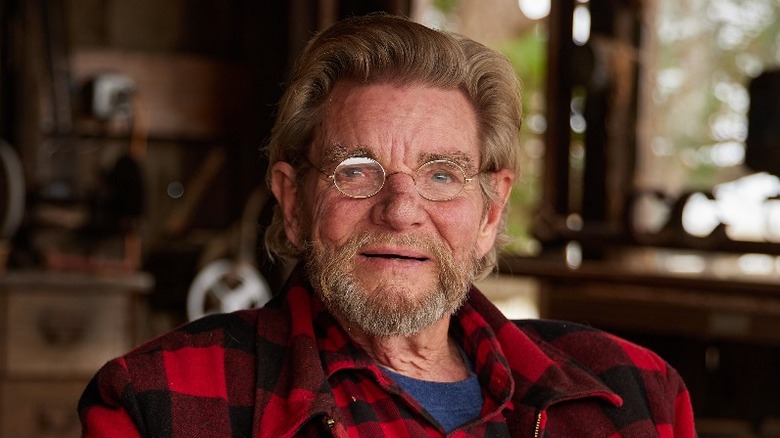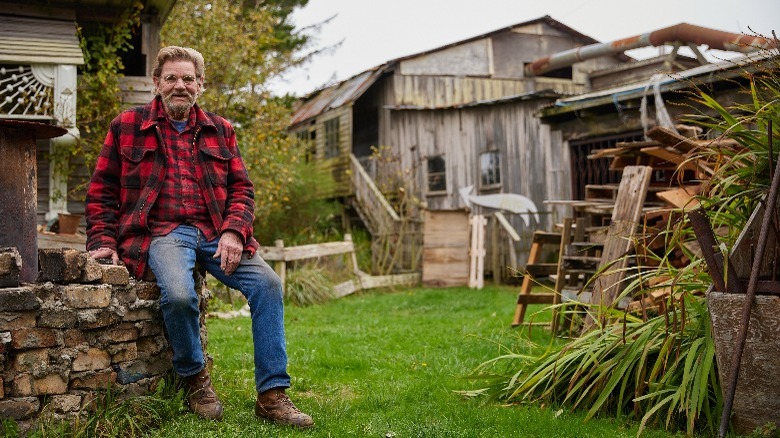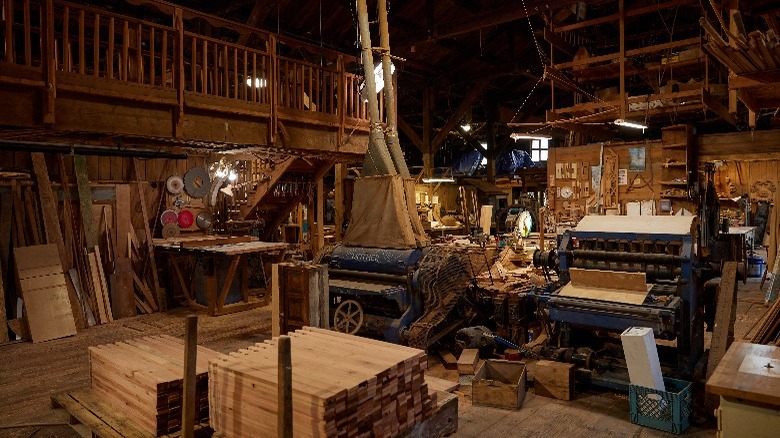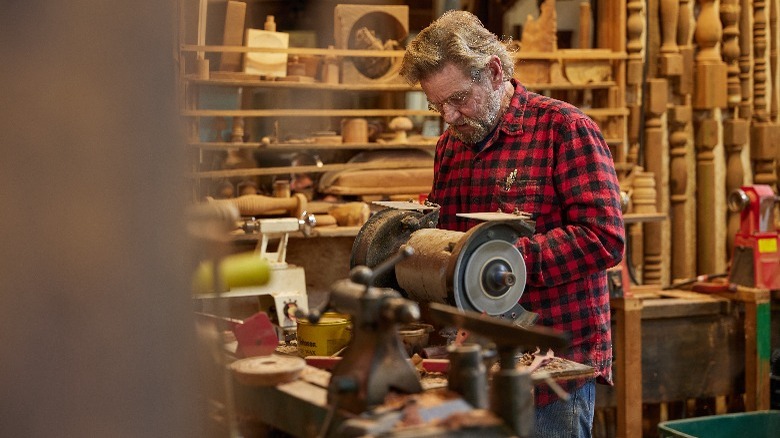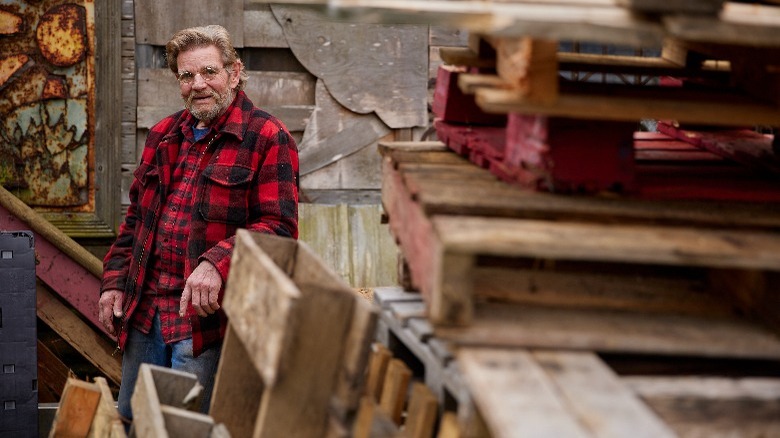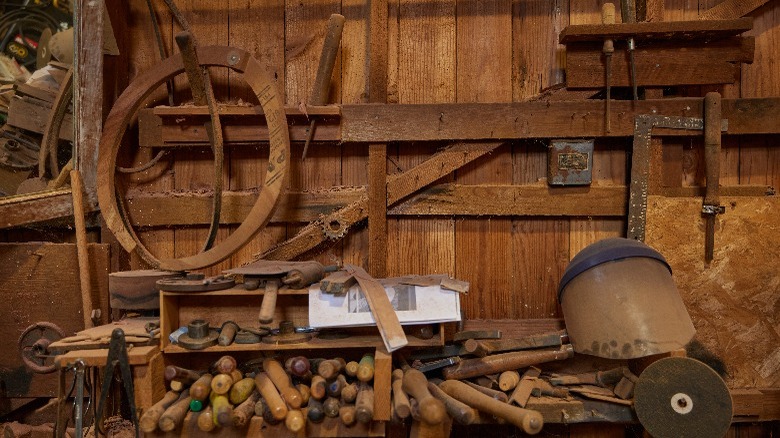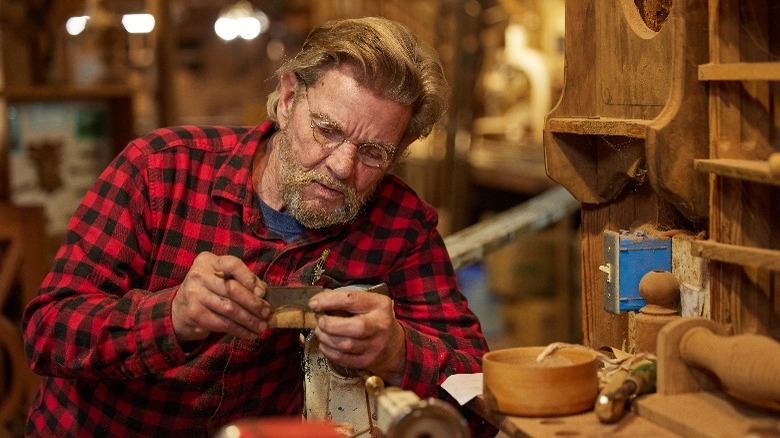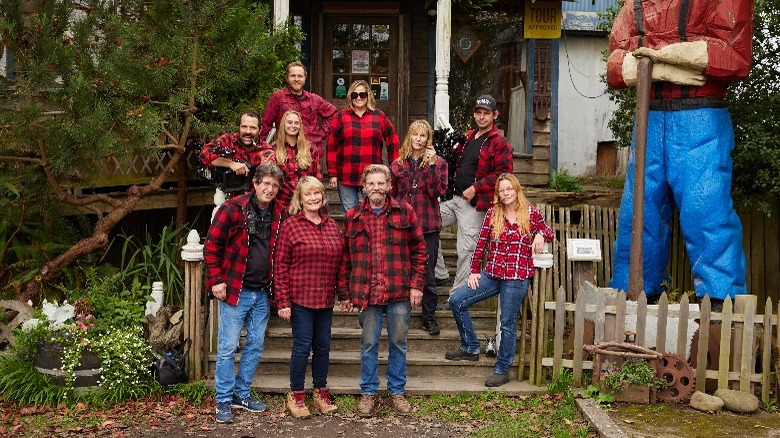Eric Hollenbeck Of The Craftsman On Building An Authentic Life - Exclusive Interview
Several descriptors come to mind when considering Eric Hollenbeck of "The Craftsman," but primarily, the one that sticks like wood glue is "genuine." He's an endearing blend of Kurt Russell, your dad or granddad (depending on your age), and a young-ish Santa Claus (he smokes a pipe, and there's a twinkle in his eye). His proximity to a kind of toymaker and his signature red flannel charge the comparison with authenticity.
Hollenbeck makes and repairs things to bring others joy. For example, he built a trolley to ferry visitors into town and printed yearbooks annually for his high school students on an old press. Hollenbeck makes things because it's who he is, and he says that crafting and woodworking gave him a place in the world.
Watching Hollenbeck's Magnolia Network show is a slow, calm experience, yet it's riveting. Each episode follows a restoration project, and we see Hollenbeck's wheels turning as he figures out how to approach it. His woodshop is pleasantly messy, though he seems to know where everything is. His hometown and the location of his business, Blue Ox Millworks, is unbelievably idyllic. It's a showpiece for nature and Victorian architecture.
Hollenbeck speaks through the camera, teaching about wood and tools and other more encompassing lessons. He engenders a trust the likes of which the aforementioned characters might instill, a trust in life in general — that it's good, that you're worthy, and that it's what you make it. He would, however, tell you that you can't do it alone.
We talked with Eric Hollenbeck about his history and pursuit of crafting.
A home to return to
You live and work in a stunning place, Eureka, California, and you grew up there, too. It's near the Redwood Curtain and the water, and the town is filled with period Victorian architecture. Could you be the craftsman you are somewhere else?
I don't believe so, no. Because I never went to school, this community became my school and my higher education. In the early days, I was asked to duplicate moldings, duplicate turnings, duplicate doors, do all of the architectural stuff. I would have to look and look and look [and think], "How did they do that? How do I do that? How does this happen?" and put all of that together. It became my education.
I remember, I went into the bank to start Blue Ox and asked for a $300 bank loan to start a logging company. And the banker laughed. He laughed so loud, the entire bank turned around and looked at me. I got to tell you, I felt about that tall. But he said because he knew my family, he knew my history, knew that I was back from Vietnam and hadn't gone to higher education ... He knew all that background, [so] he said, "Look, Eric, I'm going to give you the money, and you're going to be back for more, and I might give you some more, and you're going to be back for more after that. And at some point, I'm going to cut you off, but I want you to know that you will get an education one way or another. You're going to get an education."
At 22, I had no idea in the world what he was talking about. At 75, I know full well what he was talking about. ... It was that backing of the community at large because of my history in the community that allowed me to develop into the person I am today.
Planning versus improv
You said when you build something, you already see it. Do you plan a lot, or is there a good deal of improvisation in your work? And how close is the final result to the vision?
Every big job ... like the Lincoln hearse ... a reproduction Lincoln hearse that we did [of the one] that carried Abraham Lincoln in 1865 — these are insurmountable jobs. These are jobs that can't be done, and I've done lots of these. And I'm not blowing my horn. [For] every one of them, I have to learn the exact same first lesson all over again. When we did the hearse, I lost the first three weeks of the year that we had to do it trying to outthink the problem. You can't do that. You don't even know the questions to ask yet. What you have to do is start making sawdust, start cutting boards, knowing you're going to throw the first couple away because you were off on the wrong tangent.
Jump into it feet first and then solve every problem that comes up, because the problems will come up one at a time. You can look at them, you can analyze them, and you can solve them one at a time. There's an old proverb that says, "Even a mouse can eat an elephant if it takes small enough bites."
Preservationist or toymaker?
The environment you're in has spurred on your role as a preservationist. You've helped restore historic homes, churches, and other structures, but you also take on commercial work, including a project for former president Bill Clinton. What has been the ultimate project for you thus far?
The ones that I will die with in my memory? The table for Clinton, because that pushed my envelope so far. That went way past. I had to learn everything building that. That was the first piece of furniture I'd ever done.
The Lincoln hearse, because that was undoable. That couldn't be done. The building of the trolley — I built that trolley. I cut up an old bus with a set of cutting torches and made a trolley out of it.
All of those things are wonderful, but the one I will die with was, we had a little boy come through on a tour, and he [had a disability]. It was him and his mom. He says, "Mr. Eric, could you make a tyrannosaurus rex?" And I said, "Yeah, I think I could. Can you draw it? You draw it and I can make it." I thought that'd be the end of it. They went through on the tour [and] left.
Two weeks later, I got a letter. "Mr. Eric" — that's all it said, and the postman knew where to bring it. I opened it up, and here's a drawing of a tyrannosaurus rex. And he had arrows [labeled], "Arms move here, teeth here, legs move here." So I made that little 12-inch-tall tyrannosaurus rex for him out of some oak that I had and made his little arms move ... and made his little legs move ... put teeth on it, all the stuff he said.
Two years later, the mom came back through on her tour. She said that was the most special thing ever for that little boy. Because of his [disability], he was always ragged on in school, but at show and tell, he got to show that to the class. Then he took it around to every student's desk. He wouldn't let them touch it. And he moved the arms and ... the legs and ... showed where the teeth were ... And from that point on, he was respected in the class. And that happened three years running for that little boy.
The mill's evolution
You established Blue Ox Millworks more than 40 years ago. Now, it's one of eight Victorian mills in the U.S. Aside from being a woodshop, it's come to house a foundry, a forge, and a printing press. You're self-taught. Is it safe to say you and the mill grew up together? And how integral are these other crafts to your primary work?
Blue Ox and Eric Hollenbeck have most assuredly grown together. Blue Ox started from a $300 bank loan. That ain't $300 to the good; that's a minus $300. Eric started with an education experience that was not great and combat [experience] in Vietnam at 19. That was a minus. I remember my mom saying one time, her Eric never did come home. So we have indeed grown together.
The whole reason for the other trades was ... Let's take the print shop, for instance. [My wife] Viviana in the late 1980s said, "We need a catalog to show what we do and get word out and get people to order." Everybody [else would] think, "How do I get a catalog printed?" Eric doesn't do that. Eric thinks, "How do I print a catalog?" So I found an old print shop that ... had gone out of business and got the printing press and some type and started trying to figure out how to print a catalog from it. Of course, then the internet came along and catalogs went obsolete overnight.
The ceramic shop happened because we did a job for a Victorian. They said, "The contractors — when they were doing the demolition on the house and taking the stuff out, they broke six of these Victorian tiles. Could you remake the Victorian tiles along with the rest of the job?" I needed the rest of the job to stay alive, to keep dinner on the table, so I had to say, "Yeah, no problem." Then I had to figure out how you make tiles. So it's been a process. It's been absolutely organic. The river keeps pouring into the lake, and the lake keeps filling up.
Higher education
You and your wife, Viviana, have created a high school at the mill for at-risk kids. Would you like to tell us a little bit more about that?
We created the high school program ... It was a fluke. It was an absolute fluke that the counselor from a junior high called and said, "I got a little boy that I'm losing through the cracks, and there's nothing I can do about it. Can I bring him down and introduce him to you?" ... He was a great young man; he was just on the skids. I got him a job that he could earn $600 at, and we made a Victorian ironwork fence. ... [We] made 150 feet of it or something, and I bought all the materials so that he got all the money. He and I worked together for six months. ... [Then] they let him back into school, and he did indeed graduate from high school.
That was the very first of it. Then we set up a program with the community schools. ... It's the last rung of the ladder after you've been kicked out of all of the other alternatives. ... Viviana and I worked with those kids for 19 years until we couldn't do it anymore because Blue Ox paid for it all. We financed it. [These] numbers might be wrong. They gave us $3,000 a year for 18 kids to be here two days a week. That didn't pay for the instructors; that didn't pay for the material. ... Finally, our daughter said, "You can't do that anymore." ... And now the community schools have come back and have also started sending students down and actually paying for them.
You shared that you suffer from a grammatical learning disability and left school at 16, but you found a purpose and livelihood in craft[ing]. It seems to have its own language that you've mastered: plinth, spandrel, bright work, bargeboard. What has this identity meant for you?
To find your own identity is all any of us are trying to do in this life. That's our job. The whole point of growing up is to find out who you are. In the finding out of who you are, you find out what you're good at. ... Life gives every one of us a compensator, something we're extra good at. Find it; play to your compensator. ... What I have to do is become the very best I can at what I do. ... That's my job.
On being a responsible homeowner
While people like modern functionality in their homes, the awareness of the responsibility and benefits of preserving history seems to be growing, yet that involves expensive and time-consuming work. How do you suggest homeowners balance the way we live now with history and possibly a tight budget?
Today, [there] is a really fine, fine line that we have to walk as fellow human beings because we're all in this game together, every one of us. Take, for example, a putty knife. ... You can buy a putty knife anywhere for a buck and a half. ... Do you realize how long and how hard I would have to work in the blacksmith shop to make that putty knife? To draw that material out, that thin, to make a handle for it, to heat treat it so that it would bend and not break and still be strong? It's unbelievable. But because we pay a buck and a half for it, we leave it outside when we're done, and then it rusts away because it'll rust instantly, and the next day it's not a putty knife anymore. It's no good.
It's that thought, it's that responsibility that if we're going to buy something, then we need to take care of it. We [have to] start looking at, what do we buy? Do I buy the putty knife with a plastic handle that is likely to break ...? Or do I spend another buck and a half and get one with a wooden handle that I can keep well oiled, both the handle and the knife, and I know that I've got a putty knife for the rest of my life? That's the flip and mentality that we have to look at.
That [includes] furniture. Am I buying something that's made out of pressboard with a picture glued on the outside of it to make it look like it's real wood? If that's all I can afford, then God bless me, but it's up to me then to know that I have a very fragile piece of furniture that is not going to endure time unless I take extra-special care of it. And even then, all that I can do is get as [much time] as I possibly can [out of] it. Or am I buying a piece of furniture made out of a solid material that's way more expensive but is going to be way easier to pass on to my kids?
It's a mindset change, and it's a mindset change made very, very difficult for us by mass production. Mass production makes it too inexpensive, and the minute it's inexpensive, it's not worth straightening the nail anymore because I can buy a nail for a penny anywhere. [A bent nail is a] perfectly good nail, and all I got to do is straighten it out.
Future craftsmen
For those who are stewards of an antique home, what specific things can they do to highlight its riches and ensure its maintenance for years to come?
Control water. That's the whole thing in a nutshell. It's the three sisters: wood, steel, and water. You can have any two sisters you want and they get along great, but you put all three sisters together and you've got a catfight. [Water is] the one thing that you can control. You can't control the wood. The wood's already there. You can't control the steel. They nailed the boards on. The one thing you can control is the water. Control water; get water away from the wood, with paint [or] however you have to go about doing it.
You've called on other craftsmen to share their knowledge with the next generation, and you want young people to understand that working with their hands is a noble occupation. Why do you feel this is so important, and how do you suggest someone start if they want to learn more about craft[ing]?
It's important because most of the education field and media field are not telling young people that there is a life in the trades, a good life. The trades are screaming at the top of their lungs, "We need people; we're paying big money," and I'm talking big money. And nobody's hearing it.
Our senator years ago ... came down to the shop. She and I talked, and she said, "Yes, yes, yes, you're right," and then turned right around the next day and said, "Without a college education, you're not going to go anywhere." That rolls off our tongue[s] now. That's been hammered into us so long that people say it without even hearing the words. But guys like me hear those words, and we hear, "We're not going anywhere." And that is not the message to be sending.
There's only two kinds of jobs in the whole world. There's a job [in which] you take a shower before you go to work in the morning, and there's a job [in which] you take a shower when you come home from work at night. And the world needs both of us.
Are there any exciting projects on the horizon you'd like to share?
We may be starting to build a craftsman's village. Viv and I started beating the drum for this idea in 1990, and it may this year start to happen. That's in the 10 acres next door to us. That's an exciting thing for me.
"The Craftsman" is now streaming on HBO Max, discovery+, and the Magnolia app.
This interview has been edited for clarity.
